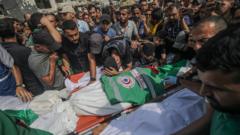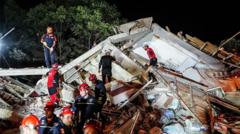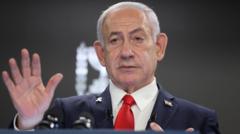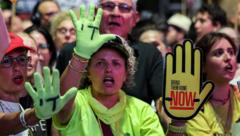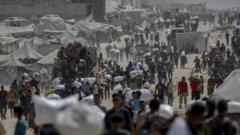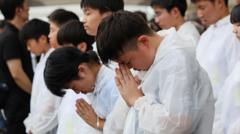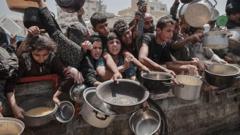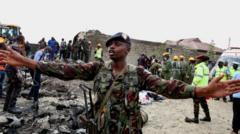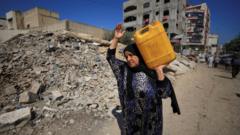In a tragic escalation of violence in Gaza, Israeli forces reportedly killed over 51 Palestinians and injured hundreds at an aid distribution site, prompting urgent calls for accountability and an investigation into the ongoing humanitarian crisis fueled by military actions and food insecurity.
Rising Toll: 51 Palestinians Killed in Gaza Aid Site Shooting

Rising Toll: 51 Palestinians Killed in Gaza Aid Site Shooting
Gunfire at aid distribution sites continues to claim lives as 51 Palestinians are reported killed while awaiting flour in Gaza.
Israeli forces opened fire at an aid distribution site in southern Gaza, leading to the death of at least 51 Palestinians and injuring more than 200 others, according to witnesses and local rescue workers. The incident occurred in Khan Younis as individuals gathered to receive flour from World Food Programme (WFP) supplies, illustrating the increasingly perilous situation in the region amid ongoing military operations.
The Hamas-run civil defense agency reported that Israeli troops fired at crowds near the aid site where numerous civilians had assembled. Eyewitness accounts indicated that, shortly after Israeli drones fired missiles, tank shelling ensued, contributing to the high casualty count. Medical facilities in the region, particularly Nasser Hospital, are reportedly overwhelmed with casualties, struggling to cope with an influx of wounded individuals lying on floors due to limited space and resources.
This incident represents the latest in a series of deadly interactions between Israeli forces and crowds assembled for aid distribution, raising alarm over the correlation between these events and the humanitarian crisis deeply affecting Gaza residents. Experts, including WHO officials, have pointed out that the trauma injuries primarily stem from gunshot wounds during food distribution events.
In response to the shooting, the Israeli Defense Forces (IDF) acknowledged there were injuries related to their fire, but stated they recognized a situation developed around a stuck aid truck near operating troops. The IDF asserted that warnings were issued to the public not to approach military personnel. However, the continuous influx of casualties raises questions about the safety of aid distribution points.
The complex dynamics surrounding these events are further complicated by the fact that international media organizations, like the BBC, are unable to report from inside Gaza, hindering independent verification of incidents. Local authorities and organizations, including the Gaza Humanitarian Foundation (GHF), are entangled in the situation, with criticism directed at the GHF's involvement in enabling aid distribution without adequate security measures in place.
Recent trends indicate a breakdown in both security and the distribution of humanitarian aid, as attempts to deliver vital supplies are often met with violence. The ongoing situation reflects not only the profound humanitarian challenges faced by Gazans but also raises broader questions about the role of aid agencies and the political motivations behind current efforts to deliver assistance.
In light of recent tragedies amidst worsening conditions, humanitarian leaders are calling for immediate investigations into the violence associated with aid distribution. UN officials and reports highlight the alarming trend of food insecurity being weaponized in conflict, further emphasizing the urgent need for a reevaluation of the humanitarian strategies at play in Gaza.
As violence and food shortages continue to plague the lives of countless Palestinians, there remain increasing voices calling for accountability and innovative approaches to prevent further loss of life while providing essential aid to those in desperate need.

